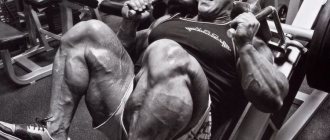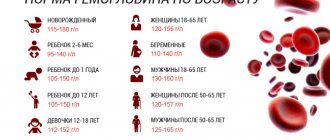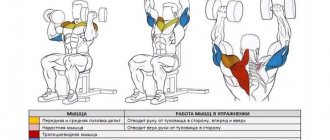In fact, split training is a classic approach to bodybuilding training. Please note that the majority of gym goers (the male half) exercise precisely according to this scheme, and this scheme is a training process that is divided into certain muscle groups and laid out for a certain period of time - a week, for example. Yes, this method is not the best option for beginner athletes. Before split training, it is better to focus on training the whole body and not break it down into muscle groups for at least a month.
What is split training
Split training is a way to create a highly effective program in which 2-3 muscle groups are worked out in one session. Moreover, in this mode there is an opportunity for complete rest and the best recovery. So, for example, if we consider the classic triple split, which is essentially a division of the body into three parts, which are worked out on different days during the week.
With such training, each group has the opportunity to recover for a week. For example, if an athlete does legs on Monday, then the next time he will train legs on Monday. Also, with this training strategy, you can successfully alternate, add and combine exercises or experiment with combining muscle groups.
Option B training program 3 times a week
And another 3-day training program. The second option is more designed to develop strength qualities.
Day 1
- Cardio and warm-up.
- Hyperextension: 2 to 15.
- Deadlift: 5 sets of 5 reps and a sixth set of 60% of the working weight for 15 reps.
- Bench press: 5 x 5 with heavy weight, but not maximal.
- Biceps hammer: 2 x 10.
- Abs: 2 x 2 hanging leg raises with weights and 2 x 10 Roman chair crunches with a dumbbell.
Day 2
- Cardio and warm-up.
- Bench press: 3 x 5 and 2 x 3 with maximum weights.
- Hammer chest press: 3 x 8-10 with maximum weights.
- Crossover raises, dumbbell raises lying on a horizontal bench with supersets: 2 x 10 and 2 x 10 (alternate 1 set of raises with 1 set of raises).
- Extension of arms on a block: 3 x 10, 1 x 8, 1 x 6, 1 x 4 - we make a “ladder” with increasing weights. You must push yourself to the limit for the last 2 reps of each set using proper technique.
- Abs: Roman chair crunches 3 x 10 with weight.
Day 3
- Cardio and warm-up.
- Barbell squats: 5 to 5.
- Leg press: 3 x 8–10.
- Lat pulldowns or pull-ups with a narrow reverse grip: 4 to 8 with weights.
- Pullover: 2 to 10.
- Cardio: 15 minutes with 1 interval.
You can remove the deadlift and replace it with the leg press. It all depends on your physical capabilities.
Isolated exercises should be eliminated. You can change various auxiliary elements every 2 weeks, for example, bringing your arms together in a crossover to pressing dumbbells upside down, or lunges with dumbbells to straightening and bending your legs in a machine.
Benefits of a split program
According to scientists and sports doctors, muscle hypertrophy is a long-term process. On average, the growth of muscle fibers after a single intense load continues for two or even three weeks. In this case, training designed to work all muscle groups in one workout actually inhibits the development of skeletal muscles and, naturally, reduces the effectiveness of training. By the way, such training will quickly lead to exhaustion of the body. The athlete’s body will spend all its energy on recovery, the growth phase will not start.
Split training allows you to efficiently work out specific muscle groups during a workout and recover effectively during the allotted time for rest, that is, until the next workout. Split training is best for gaining muscle mass.
Flaws
Despite such powerful advantages, split programs also have disadvantages:
- High level of difficulty
There are schemes that will suit almost everyone. However, the training volume per muscle group increases several times and for some this becomes too difficult a task.
- Frequent workouts
This mainly applies to 4-6 day programs. Not everyone has the opportunity or need to visit the gym so often.
Most amateurs stick to three-day splits. This is the best option for muscle growth, recovery of the body, and in terms of time costs.
Who is suitable for split training?
Split training is suitable for athletes who have a certain athletic level, when training for all muscle groups becomes insufficiently effective. Split training is also perfect for bodybuilders who deeply work each muscle using different training methods and a whole range of exercises. But this type of training should not be recommended for beginners until the body has adapted to physical activity. And the amount of load that split training provides is also useless for beginners or athletes after a long break in training.
Hammer curls for biceps (hammer)
Another exercise that develops the brachialis.
Initial position:
- Take dumbbells in your hands with your hands facing you.
- As you exhale, bend your elbows and lift the dumbbells to your chest.
- The position of your hands should be as if you were holding a hammer in your hand (hence the name).
- As you inhale, slowly lower your arms.
This exercise can be performed with both hands together or alternately. You can also do it both standing and sitting. When performing while sitting, you will not be able to cheat much by swinging your body.
The right approach to split training
- You need to start with training for all muscle groups. You need to practice in this mode for at least one to two months. During this period, training is a set of basic exercises and linear cycling of training is used. It is divided into 4 stages, but we will not dwell on this, since this is a separate large topic.
- After this phase, the training process can be transferred to a two-day split training. This phase can last from several months to six months. Basically, basic exercises are used at this stage.
- The next stage will be a three-day split. This program is a classic of sorts. By the way, another feature of split training is the alternation of different exercises and muscle groups in the first and second weeks. This prevents the body from getting used to the load and adapting to the exercises, which makes the training more effective.
- In addition to the three-day split, there is also a four-day and a five-day split. Such options allow you to further increase the load and work out specific muscle groups more effectively. With such training, the number of approaches and exercises for each muscle group increases. Typically, four and five day splits are used by professional athletes or athletes using hormonal anabolic drugs. The training uses both basic and isolation exercises. Athletes of average training level do not need this type of training at all and will not give the desired result.
- It is also worth adding that in split training mode, you can work out either synergist muscles, for example: pectoral muscles, anterior deltoid and triceps, or antagonists - chest and back muscles, biceps and triceps in one session. Read more about antagonist and synergist muscles →
- High-level athletes can split their leg workouts into quads and soleus, and then hamstrings and calves.
How many days a week do you train?
For the correct pace of training, a classic combination is recommended for beginners - 3 days of hard training per week involving all muscle groups. With such intensity, the body will have time to pump up and recover. The combination is called the term “split” - a training plan for 3 days. A split involves performing exercises in three sets of eight to ten repetitions with three-minute breaks between sets. Before starting classes, a fifteen-minute warm-up is required, followed by pumping - the first exercise from the complex is repeated twenty times with a small weight to warm up and pump blood to the muscles. The following elements are performed with working weights. The duration of the workout should not be more than one and a half hours.
We recommend reading: How to pump up your abs in 1 month
Bent row
Bent rows can be performed with dumbbells, machines or a barbell. It all depends on your body weight and fitness level.
Any bent row will have an impact on your sides, so pull the load to both the left and right.
This way you will gradually pump up the muscles on both sides.
A little history
In my articles I often plunge into the past, and this time will not be an exception. So, in the early days of bodybuilding, the dominant training approach was one that advocated training the entire body in a training session. This training approach was called full - body training . Athletes simply trained each muscle group in their body, performing one basic exercise for each of them. At the next training session, it was possible to replace the exercises with similar ones and change the order of their execution.
With increasing training experience, athletes noticed that increasing the volume of loads and working the entire body for each workout became too tiring. They began to divide their body into conditional zones and work on them on separate days. This is how the split approach was born - separate training .
According to another theory, the emergence of split training was significantly influenced by the beginning of the use of various pharmacological drugs in sports.
Pull-ups
Pull-ups are considered the simplest and most cost-effective option for pumping up your back muscles.
With their help, you can freely apply the load, but to do this, you need to place your hands as wide as possible in order to apply the necessary load on your back.
But pull-ups are not enough to give yourself real “wings.”
Features of a three-day split[edit | edit code]
In a three-day split, the body's muscles are divided into three groups, and each of them is trained once during a specific microcycle, usually once a week. In addition to the weekly one, microcycles with a different number of days can be planned, for example, 8 or 9 days. Many athletes, both beginners and advanced, train using a three-day split. Here we will look at a three-day split for beginners, which has some differences from splits for advanced athletes. So, the training within the framework of a two-day split is completed and its possibilities are basically exhausted, and psychologically it is quite difficult to follow the same program for a long time. The most correct seems to be the transition from a two-day split to a three-day one. It is characterized by working out each muscle group only once during a certain microcycle, in our case once a week. This will be enough if you increase the load on the muscle groups being worked. The load will be increased both due to increased working weights in the exercises, and due to an increase in the number of exercises themselves for each muscle, as well as due to a greater number of working approaches to it.
Content
- 1 Features of a three-day split
- 2 Creating a three-day split
- 3 Program 1 3.1 Workout 1. Monday
- 3.2 Workout 2. Wednesday
- 3.3 Training 3. Friday
- 3.4 Explanations for program 1
- 4.1 Workout 1. Monday
- 6.1 Conclusion
Exercises with dumbbells
Working out with dumbbells, you pump up almost everything at once; they are often the basis of a back training program at home, since rarely do anyone have their own exercise machines that take up a lot of space in the apartment.
Lifting dumbbells in a level position is pleasant because you can “manually” influence exactly the muscle group that first needs to be pumped up.
The main thing is to do an equal number of lifts on the entire trapezoid so that the shape is uniform and ultimately beautiful.
Pullover
The pullover is an excellent exercise machine, but it is often used to pump up the arms.
Pumping is done by performing it in a level position, great for beginners.
Its advantage is that the back is always in the correct position and receives the required amount of load.











